Publications
List of publications.
2025
-
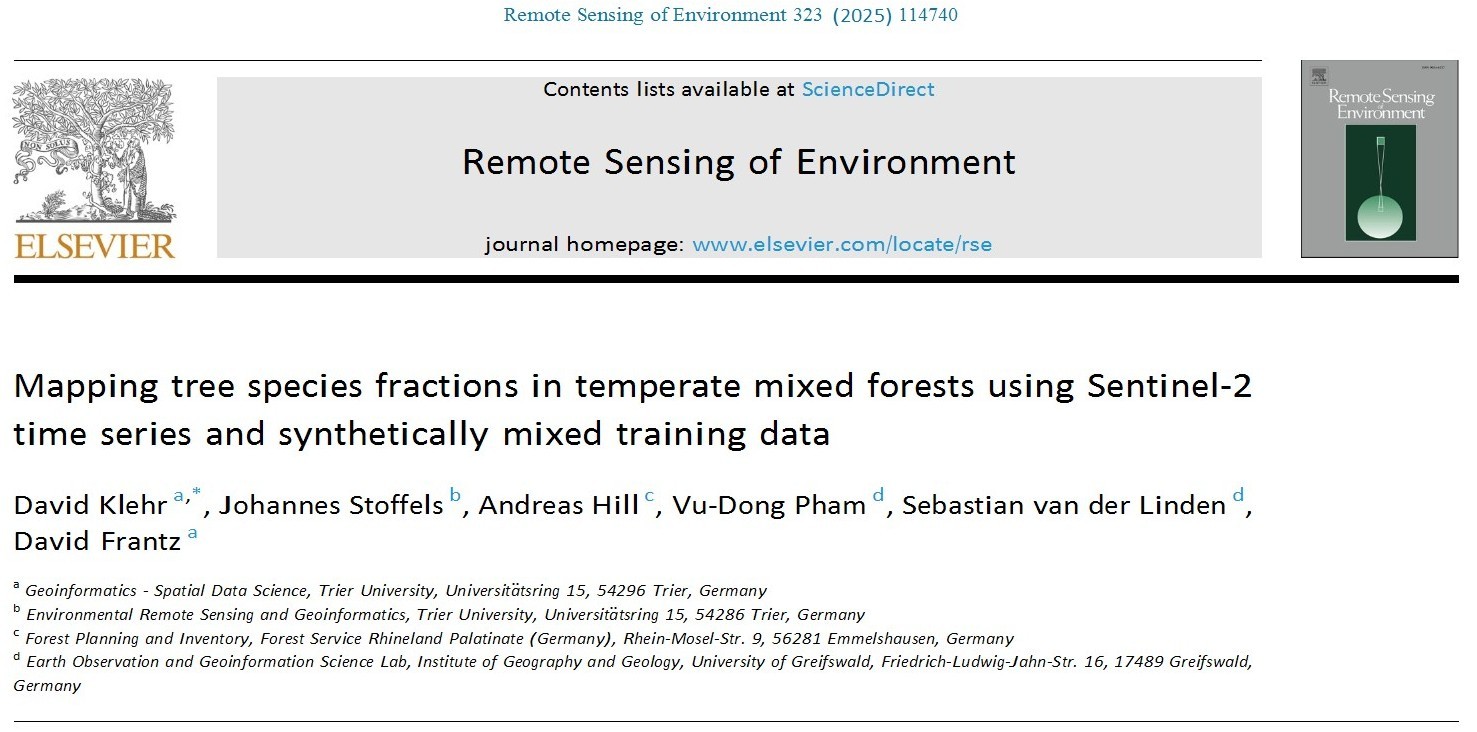 David Klehr, Johannes Stoffels, Andreas Hill, Vu-Dong Pham , Sebastian Linden, and David FrantzRemote Sensing of Environment, Jun 2025
David Klehr, Johannes Stoffels, Andreas Hill, Vu-Dong Pham , Sebastian Linden, and David FrantzRemote Sensing of Environment, Jun 2025Monitoring and mapping of forest stands, including tree species composition can support forest protection and management. Sentinel-2 imagery provide a viable data source due to their high spectral, temporal, and spatial resolution. However, especially in temperate mixed forests challenges with tree species classification persist, mainly due to the high mixing ratio of tree species, which cannot be fully resolved even with the 10 m resolution of Sentinel-2 data. Additional challenges are associated with the commonly low number of reference data for rare tree species, resulting in low classification accuracy for these species. This study proposes an approach to map sub-pixel tree species fractions in mixed temperate forests by combining dense annual multi-spectral Sentinel-2 time series to target differences between species in phenological relevant periods with synthetically mixed training data. This allows for a limited number of pure training samples per tree species, which serves as basis for randomized linear mixing to compute a synthetic spectral library. An artificial neural network is trained for regression for tree species fractions per pixel. To enhance model robustness and stabilize predictions, we implemented this library generation and artificial neural network regression as an ensemble approach. We effectively mapped tree species fractions for the federal state of Rhineland-Palatinate, Germany, with Mean Absolute Errors of 2.76% to 16.05% and R2 values up to 0.92 – when validated against forest planning data. We show that the data augmentation through synthetic mixing allows for a sample size as small as 30 pure pixels per class, to sufficiently distinguish nine tree species and one ‘other species’ class, hence substantially increasing the operational potential for deployment when reference data for rare species are limited – while simultaneously generating accurate and information-rich tree species distributions over large areas of mixed forest.
@article{Klehr2025, title = {Mapping tree species fractions in temperate mixed forests using {Sentinel}-2 time series and synthetically mixed training data}, volume = {323}, issn = {0034-4257}, url = {https://www.sciencedirect.com/science/article/pii/S0034425725001440}, doi = {10.1016/j.rse.2025.114740}, urldate = {2025-04-07}, journal = {Remote Sensing of Environment}, author = {Klehr, David and Stoffels, Johannes and Hill, Andreas and Pham, Vu-Dong and van der Linden, Sebastian and Frantz, David}, month = jun, year = {2025}, keywords = {Sentinel-2, Tree species, Forest inventory, Time series reconstruction, Synthetic training data, Regression-based unmixing, Neural network regression}, pages = {114740}, }
2024
-
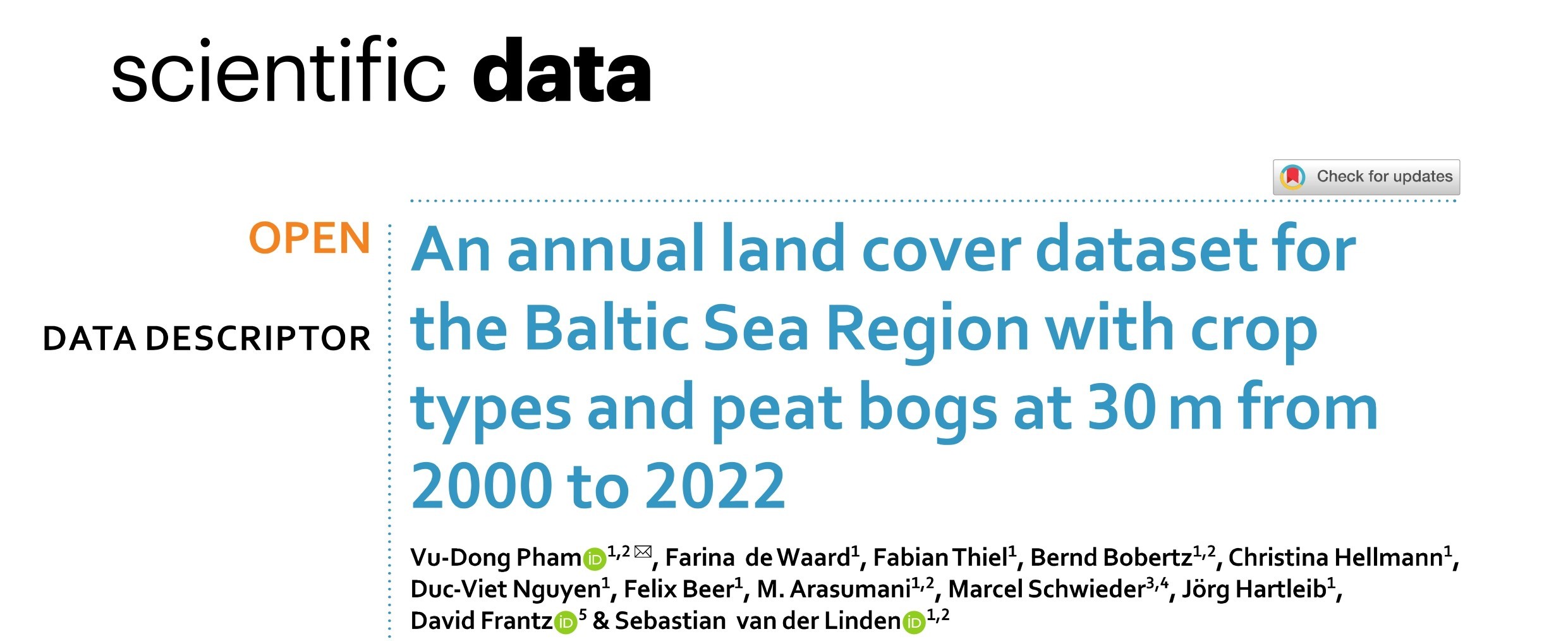 Vu-Dong Pham , Farina Waard, Fabian Thiel, Bernd Bobertz, Christina Hellmann, Duc-Viet Nguyen, Felix Beer, M. Arasumani, Marcel Schwieder, Jörg Hartleib, David Frantz, and Sebastian LindenScientific Data, Nov 2024
Vu-Dong Pham , Farina Waard, Fabian Thiel, Bernd Bobertz, Christina Hellmann, Duc-Viet Nguyen, Felix Beer, M. Arasumani, Marcel Schwieder, Jörg Hartleib, David Frantz, and Sebastian LindenScientific Data, Nov 2024We present detailed annual land cover maps for the Baltic Sea region, spanning more than two decades (2000–2022). The maps provide information on eighteen land cover (LC) classes, including eight general LC types, eight major crop types and grassland, and two peat bog-related classes. Our maps represent the first homogenized annual dataset for the region and address gaps in current land use and land cover products, such as a lack of detail on crop sequences and peat bog exploitation. To create the maps, we used annual multi-temporal remote sensing data combined with a data encoding structure and deep learning classification. We obtained the training data from publicly available open datasets. The maps were validated using independent field survey data from the Land Use/Cover Area Frame Survey (LUCAS) and expert annotations from high-resolution imagery. The quantitative and qualitative results of the maps provide a reliable data source for monitoring agricultural transformations, peat bog exploitation, and restoration activities in the Baltic Sea region and its surrounding countries.
@article{Pham2024, author = {Pham, Vu-Dong and de Waard, Farina and Thiel, Fabian and Bobertz, Bernd and Hellmann, Christina and Nguyen, Duc-Viet and Beer, Felix and Arasumani, M. and Schwieder, Marcel and Hartleib, J{\"o}rg and Frantz, David and van der Linden, Sebastian}, title = {An annual land cover dataset for the Baltic Sea Region with crop types and peat bogs at 30 m from 2000 to 2022}, journal = {Scientific Data}, year = {2024}, month = nov, day = {18}, volume = {11}, number = {1}, pages = {1242}, issn = {2052-4463}, doi = {10.1038/s41597-024-04062-w}, url = {https://doi.org/10.1038/s41597-024-04062-w}, } -
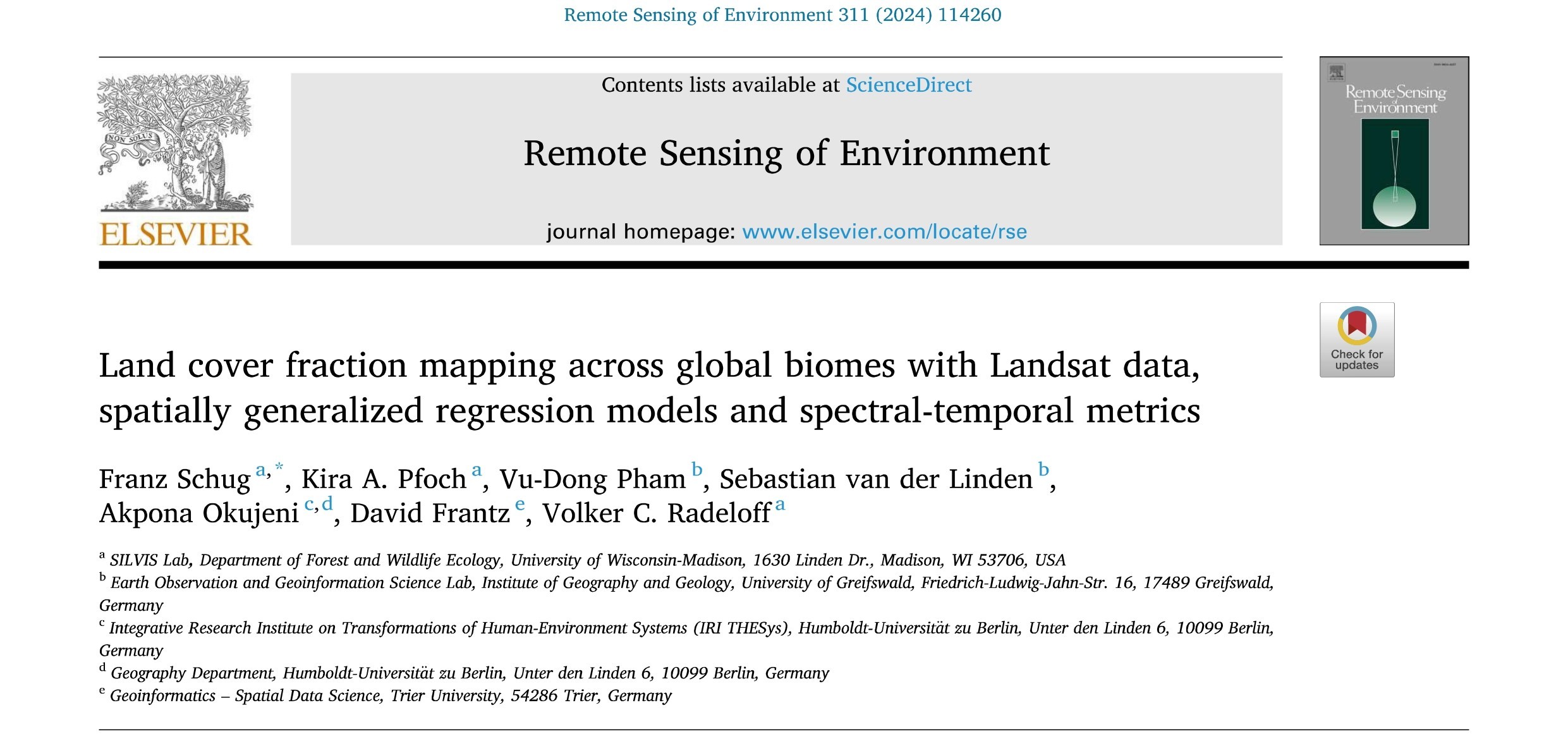 Franz Schug, Kira A. Pfoch, Vu-Dong Pham , Sebastian Linden, Akpona Okujeni, David Frantz, and Volker C. RadeloffRemote Sensing of Environment, Sep 2024
Franz Schug, Kira A. Pfoch, Vu-Dong Pham , Sebastian Linden, Akpona Okujeni, David Frantz, and Volker C. RadeloffRemote Sensing of Environment, Sep 2024Mapping land cover in highly heterogeneous landscapes is challenging, and classifications have inherent limitations where the spatial resolution of remotely sensed data exceeds the size of small objects. For example, classifications based on 30-m Landsat data do not capture urban or other heterogeneous environments well. This limitation may be overcome by quantifying the subpixel fractions of different land cover types. However, the selection process and transferability of models designed for subpixel land cover mapping across biomes is yet challenging. We asked to what extent (a) locally trained models can be used for sub-pixel land cover fraction estimates in other biomes, and (b) training data from different regions can be combined into spatially generalized models to quantify fractions across global biomes. We applied machine learning regression-based fraction mapping to quantify land cover fractions of 18 regions in five biomes using Landsat data from 2022. We used spectral-temporal metrics to incorporate intra-annual temporal information and compared the performance of local, spatially transferred, and spatially generalized models. Local models performed best when applied to their respective sites (average mean absolute error, MAE, 9–18%), and also well when transferred to other sites within the same biome, but not consistently so for out-of-biome sites. However, spatially generalized models that combined input data from many sites worked very well when analyzing sites in many different biomes, and their MAE values were only slightly higher than those of the respective local models. A weighted training data selection approach, preferring training data with a lower spectral distance to the image data to be predicted, further enhanced the performance of generalized models. Our results suggest that spatially generalized regression-based fraction models can support multi-class sub-pixel fraction estimates based on medium-resolution satellite images globally. Such products would have great value for environmental monitoring in heterogeneous environments and where land cover varies along spatial or temporal gradients.
@article{Schug2024, title = {Land cover fraction mapping across global biomes with Landsat data, spatially generalized regression models and spectral-temporal metrics}, volume = {311}, issn = {0034-4257}, url = {http://dx.doi.org/10.1016/j.rse.2024.114260}, doi = {10.1016/j.rse.2024.114260}, journal = {Remote Sensing of Environment}, publisher = {Elsevier BV}, author = {Schug, Franz and Pfoch, Kira A. and Pham, Vu-Dong and van der Linden, Sebastian and Okujeni, Akpona and Frantz, David and Radeloff, Volker C.}, year = {2024}, month = sep, pages = {114260}, } -
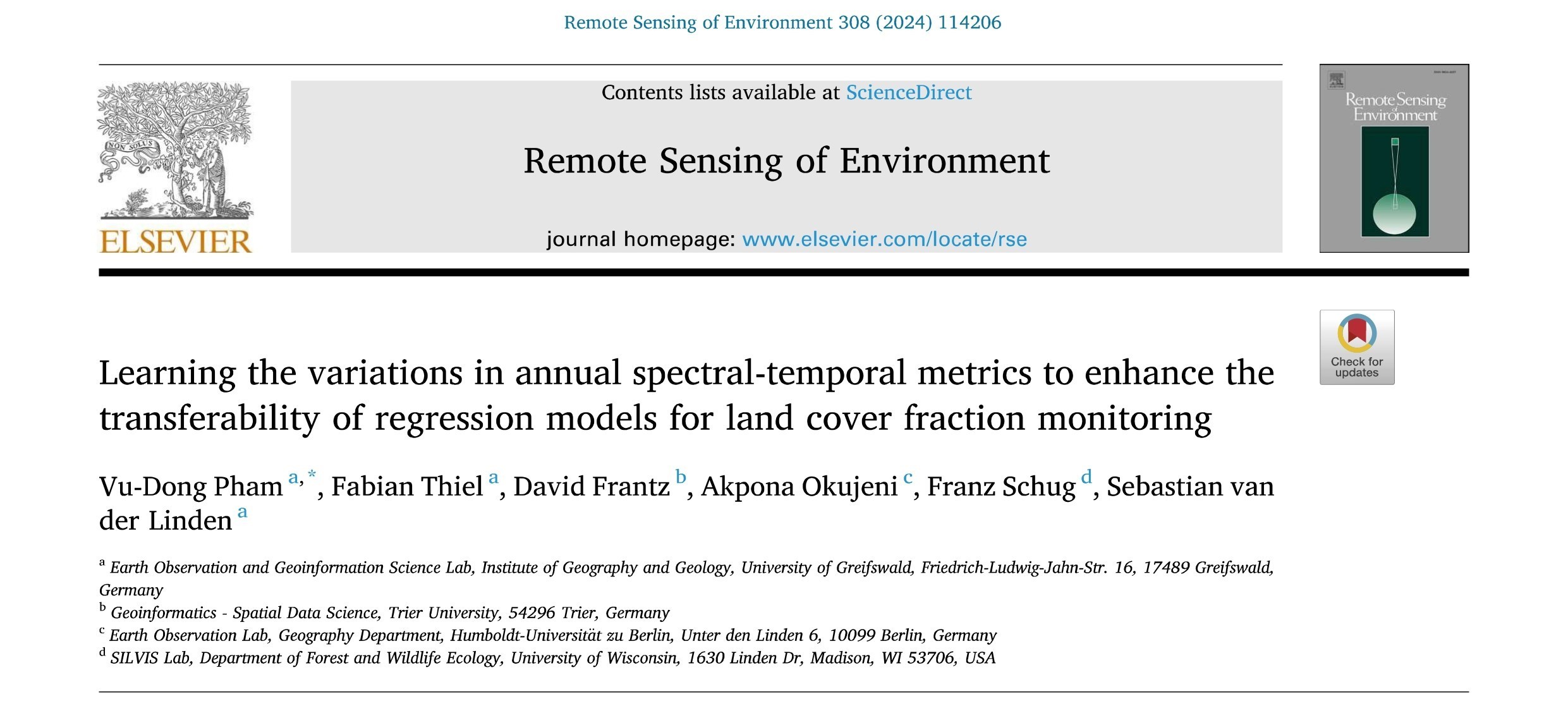 Vu-Dong Pham , Fabian Thiel, David Frantz, Akpona Okujeni, Franz Schug, and Sebastian LindenRemote Sensing of Environment, Jul 2024
Vu-Dong Pham , Fabian Thiel, David Frantz, Akpona Okujeni, Franz Schug, and Sebastian LindenRemote Sensing of Environment, Jul 2024Monitoring the Earth by annually mapping land cover (LC) fractions helps to better understand the ongoing processes and changes of land use and land management. At 10 to 30 m spatial resolution, the combination of time-series data aggregation, specifically spectral-temporal metrics (STM), and regression-based unmixing models has been shown to be highly effective in quantifying LC fractions over large areas. However, STM are subject to variations in data densities within and between years, which may lead to variations in prediction accuracies and limit the transferability of models through time. To better understand the influence of annual data density on multi-year monitoring, we systematically tested the accuracy and spatial-temporal transferability of regression models for LC fraction mapping. Additionally, we introduced a novel strategy, Random Observation Selection, in the STM generation to enhance model transferability and compared its results to those obtained from regular STM. We used STM from multi-spectral Sentinel-2 satellite data to estimate Impervious surface, Woody and Low vegetation at a regional scale in northern Germany and Poland for the years 2017 to 2022. The study period is characterized by substantial inter-annual variation in data density and well suited to test temporal transfer: in the extremely hot and dry years of 2018 and 2019 data density is above average and considered relatively high, while in the wetter years of 2017 and 2021 it is low. The mapping quality of models trained in single years varied considerably between years with high and low data density. Specifically, models trained in years with high data density performed well in that same year but poorly when transferred to years with lower density. Conversely, models trained in years with low data density demonstrated less of a decrease in accuracy when transferred. A multi-year model trained in all six years performs the best for each individual year. The use of Random Observation Selection improved the transferability of all models, particularly for those trained with data from a high data density year when transferred to years with lower data density. Here, the mean absolute error showed the highest relative improvement of 16%. In conclusion, STM proved useful for multi-year regression-based monitoring, but care must be taken when annual data density varies. Incorporating Random Observation Selection reduced this influence and improved the spatial-temporal transferability of quantitative LC fraction monitoring.
@article{Pham2025, title = {Learning the variations in annual spectral-temporal metrics to enhance the transferability of regression models for land cover fraction monitoring}, volume = {308}, issn = {0034-4257}, url = {http://dx.doi.org/10.1016/j.rse.2024.114206}, doi = {10.1016/j.rse.2024.114206}, journal = {Remote Sensing of Environment}, publisher = {Elsevier BV}, author = {Pham, Vu-Dong and Thiel, Fabian and Frantz, David and Okujeni, Akpona and Schug, Franz and van der Linden, Sebastian}, year = {2024}, month = jul, pages = {114206}, } -
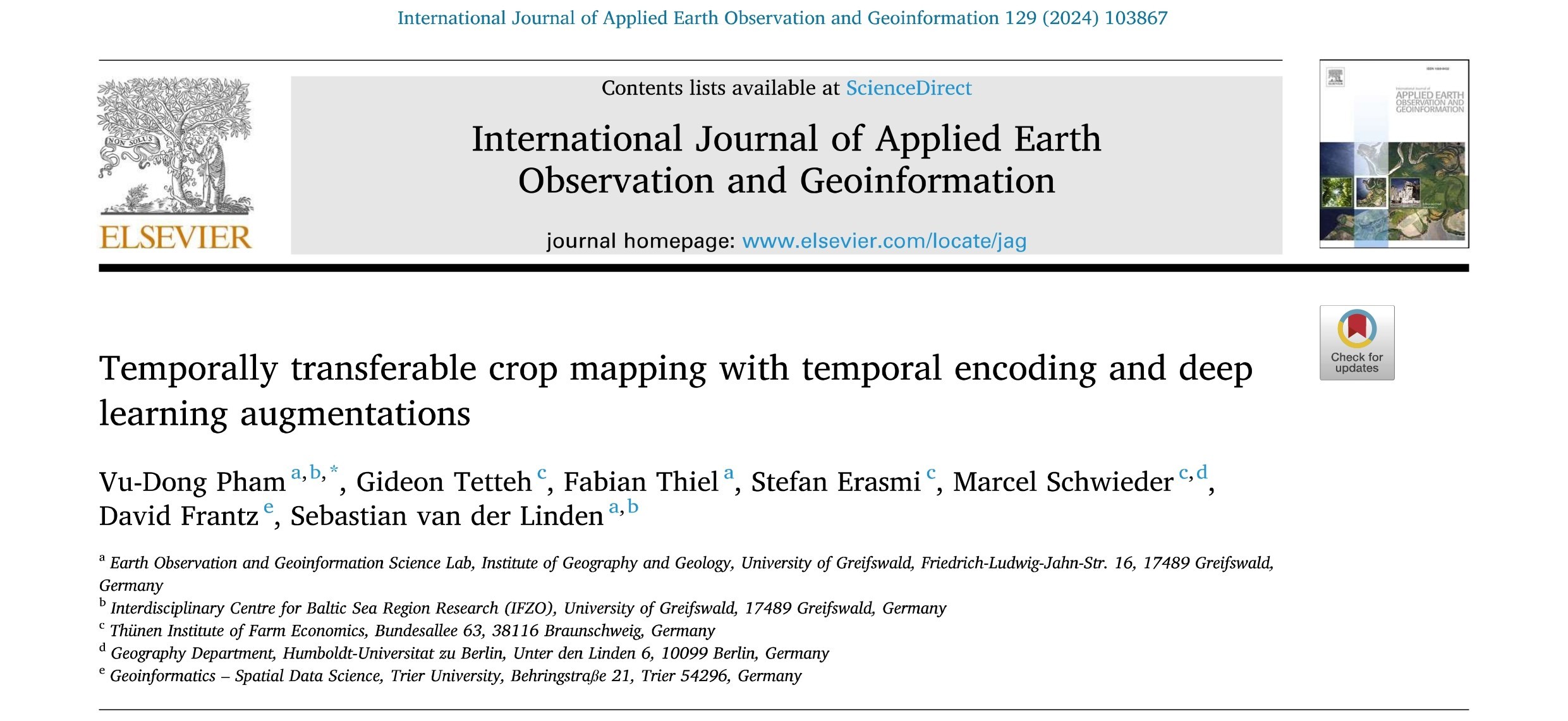 Vu-Dong Pham , Gideon Tetteh, Fabian Thiel, Stefan Erasmi, Marcel Schwieder, David Frantz, and Sebastian LindenInternational Journal of Applied Earth Observation and Geoinformation, May 2024
Vu-Dong Pham , Gideon Tetteh, Fabian Thiel, Stefan Erasmi, Marcel Schwieder, David Frantz, and Sebastian LindenInternational Journal of Applied Earth Observation and Geoinformation, May 2024Detailed maps on the spatial and temporal distribution of crops are key for a better understanding of agricultural practices and for food security management. Multi-temporal remote sensing data and deep learning (DL) have been extensively studied for deriving accurate crop maps. However, strategies to solve the problem of transferring crop classification models over time, e.g., training the model with data for a recent year and mapping back to the past, have not been fully explored. This is due to the lack of a generalized method for aggregating optical data with regard to the irregularity in annual clear sky observations and the scarcity of multi-annual crop reference data to support a more generalized DL model. In this study, we tackled these challenges by introducing a method namely Temporal Encoding (TE) to capture the irregular phenological information. Subsequently, we adapted and integrated two methods, i.e., Random Observations Selection (ROS) and Random Day Shifting (RDS) to simulate the variability of temporal sparsity as well as the shifts of crop phenology over different years. We tested this approach with a 1-dimensional Convolutional Neural Network (1D-CNN) and a Transformer Network models. Our results for both classifiers showed that models trained with crop reference data from 2018 and a dense time series of Landsat 7/8 and Sentinel-2 A/B data can be transferred with little decreases in accuracy to map 12 consecutive years from 2010 to 2021. The Transformer Network was slightly more accurate, while the 1D-CNN was much three times faster. Furthermore, the proposed models could achieve similar performances in the same years with and without fully available satellite information. The TE with ROS and RDS appears well suited for improving temporal transferability to support long term historic crop mapping.
@article{Pham2026, title = {Temporally transferable crop mapping with temporal encoding and deep learning augmentations}, volume = {129}, issn = {1569-8432}, url = {http://dx.doi.org/10.1016/j.jag.2024.103867}, doi = {10.1016/j.jag.2024.103867}, journal = {International Journal of Applied Earth Observation and Geoinformation}, publisher = {Elsevier BV}, author = {Pham, Vu-Dong and Tetteh, Gideon and Thiel, Fabian and Erasmi, Stefan and Schwieder, Marcel and Frantz, David and van der Linden, Sebastian}, year = {2024}, month = may, pages = {103867}, }
2023
-
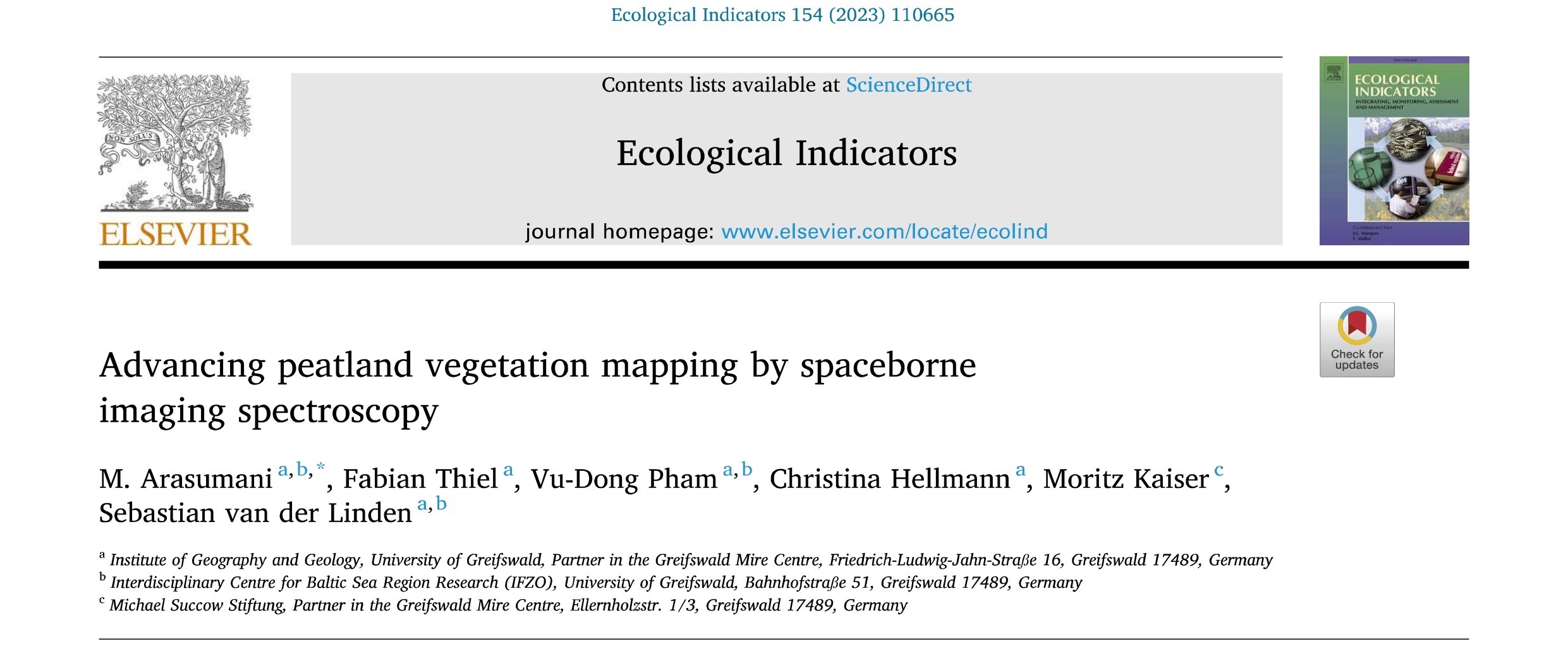 M. Arasumani, Fabian Thiel, Vu-Dong Pham , Christina Hellmann, Moritz Kaiser, and Sebastian LindenEcological Indicators, Oct 2023
M. Arasumani, Fabian Thiel, Vu-Dong Pham , Christina Hellmann, Moritz Kaiser, and Sebastian LindenEcological Indicators, Oct 2023Peatlands contribute to a wide range of ecosystem services. They play an important role as carbon sinks in their natural state, but when they are drained, they causecarbon emissions. Rewetting drained peatlands is required to reduce carbon emissions and create new carbon sinks. However, drained peatlands are commonly used as grassland or croplands; therefore, alternative agriculture schemes are required following rewetting. Paludiculture, i.e., agriculture on wet and rewetted peatlands, is an option in these areas after rewetting to produce biomass sustainably. Monitoring of peatland management is challenging, yet needed to ensure a successful rewetting and plantation of, e.g., Phragmites australis and Typha spp., two plants which are commonly used in paludiculture. Remote sensing is an excellent tool for monitoring the vegetation composition of vast rewetted peatland regions. However, because many peatland species have similar spectral characteristics, such monitoring is ideally based on high-spatial, high-temporal hyperspectral images. Data that complies with all these requirements does not exist on a regular basis. Therefore, we assessed the potential for mapping peatland vegetation communities in the Peene and Trebel river basins of the federal state of Mecklenburg-Western Pomerania, Germany, using multi-date hyperspectral (PRISMA) data. We used regression-based unmixing to map fractions of different peatland vegetation classes. Results were analyzed with regard to the contribution of multi-date observations and, in comparison, to multispectral datasets (Landsat-8/Sentinel-2). Our results showed that different classes are best mapped at different observation dates. The multi-date hyperspectral datasets produced less Mean Absolute Error (MAE = 16.4%) than the single-date hyperspectral images (ΔMAE + 1%), with high accuracies for all classes of interest. Compared to the results obtained with multispectral data from similar acquisition dates and annual spectral-temporal metrics (STM), the results from hyperspectral data were always clearly superior (ΔMAE + 4%). Besides the superior performance during comparisons, our results also indicate that information that can be derived from the hyperspectral data with the regression-based unmixing goes clearly beyond that of discrete classification. With more hyperspectral sensors coming up and an expected higher availability of multi-data hyperspectral imagery, these data can be expected to play a bigger role in the future monitoring of peatlands.
@article{Arasumani2023, title = {Advancing peatland vegetation mapping by spaceborne imaging spectroscopy}, volume = {154}, issn = {1470-160X}, url = {http://dx.doi.org/10.1016/j.ecolind.2023.110665}, doi = {10.1016/j.ecolind.2023.110665}, journal = {Ecological Indicators}, publisher = {Elsevier BV}, author = {Arasumani, M. and Thiel, Fabian and Pham, Vu-Dong and Hellmann, Christina and Kaiser, Moritz and van der Linden, Sebastian}, year = {2023}, month = oct, pages = {110665}, }
2021
-
 Vu-Dong Pham , and Quang-Thanh BuiRemote Sensing Letters, Apr 2021
Vu-Dong Pham , and Quang-Thanh BuiRemote Sensing Letters, Apr 2021Landsat and Sentinel-2 are two freely accessible satellite data that are relevant for global land cover monitoring. However, the uses of the latter data set are growing because of its higher spatial resolutions and the availability of benchmark data sets for deep learning applications. In this study, we integrate a style transfer (perceptual loss estimation from Sentinel 2 benchmark data) into a Generative Adversarial Network (GAN) to construct a single image super-resolution model. The proposed model upscales Landsat 8 images (using red, green, blue, and near-infrared bands at 30 m and Panchromatic band 15 m for high-resolution features exploiting) to 10 m (with Sentinel-2 as reference). Compared to pan-sharpening and other upscaling methods, the proposed method can produce more realistic, spatial convincing images at 10 m resolution and more similar to Sentinel-2 images than the other commonly used super-resolution imaging algorithms. As a result, the proposed method extends the usage of high-resolution benchmark data sets for lower resolution imagery to enrich supplement data sources for land cover classification.
@article{Pham2021, title = {Spatial resolution enhancement method for Landsat imagery using a Generative Adversarial Network}, volume = {12}, issn = {2150-7058}, url = {http://dx.doi.org/10.1080/2150704X.2021.1918789}, doi = {10.1080/2150704x.2021.1918789}, number = {7}, journal = {Remote Sensing Letters}, publisher = {Informa UK Limited}, author = {Pham, Vu-Dong and Bui, Quang-Thanh}, year = {2021}, month = apr, pages = {654–665}, }